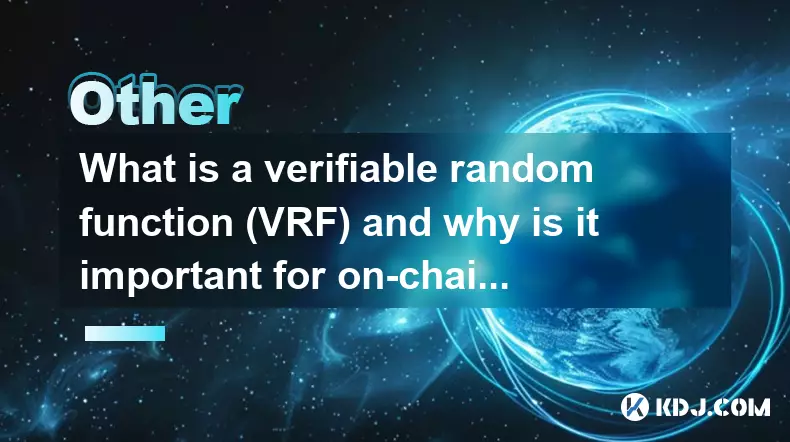-
 bitcoin
bitcoin $94896.319736 USD
-0.39% -
 ethereum
ethereum $3130.546781 USD
-0.60% -
 tether
tether $0.999368 USD
-0.10% -
 xrp
xrp $2.232415 USD
1.03% -
 bnb
bnb $931.833054 USD
0.53% -
 solana
solana $138.573946 USD
-0.08% -
 usd-coin
usd-coin $0.999844 USD
-0.08% -
 tron
tron $0.292320 USD
-0.61% -
 dogecoin
dogecoin $0.159558 USD
-1.12% -
 cardano
cardano $0.489320 USD
-1.89% -
 hyperliquid
hyperliquid $38.634250 USD
0.58% -
 zcash
zcash $700.952791 USD
3.30% -
 bitcoin-cash
bitcoin-cash $486.511218 USD
-3.00% -
 chainlink
chainlink $13.831174 USD
-1.13% -
 unus-sed-leo
unus-sed-leo $9.209054 USD
0.47%
What is a verifiable random function (VRF) and why is it important for on-chain gaming?
VRFs provide provably fair, tamper-proof randomness for blockchains, enabling transparent loot drops, NFT mints, and on-chain game outcomes with verifiable integrity.
Nov 08, 2025 at 10:19 am

Understanding Verifiable Random Functions (VRF)
1. A verifiable random function (VRF) is a cryptographic primitive that generates a random output along with a proof that the result was computed correctly and fairly. Unlike standard random number generators, VRFs ensure transparency and resistance to manipulation by providing on-chain verification capabilities.
2. The function takes a secret key and an input value to produce two outputs: a pseudorandom value and a cryptographic proof. This proof allows any third party to verify that the output was generated using the correct key and input without revealing the key itself.
3. In blockchain environments, where trustless computation is essential, VRFs solve the problem of generating randomness that cannot be predicted or influenced by miners, validators, or smart contract developers.
4. The deterministic nature of blockchains makes true randomness difficult to achieve. Traditional methods such as block hashes or timestamps are vulnerable to manipulation. VRFs eliminate this risk by ensuring that only authorized parties can generate valid randomness, while anyone can validate its integrity.
5. Projects like Chainlink have implemented decentralized VRF services that integrate directly with smart contracts, enabling secure access to verified randomness for applications ranging from NFT minting to loot box distributions in games.
Role of VRF in On-Chain Gaming
1. On-chain gaming relies heavily on fairness and transparency, especially when outcomes affect ownership, rarity, or competitive advantage. Without a reliable source of randomness, players may suspect foul play or centralization of control.
2. VRF ensures that game events such as item drops, character traits, or match results are both unpredictable and provably fair. For example, when a player opens a digital loot box, the contents are determined by a VRF-generated number, and the attached proof confirms no tampering occurred.
3. Because all data and proofs reside on the blockchain, every participant can audit past events. This level of openness builds trust among users who know they are not being cheated by hidden algorithms or backend manipulation.
4. Smart contracts governing gameplay mechanics can automatically trigger actions based on VRF outputs. Once the randomness is delivered and verified, the contract executes rewards or penalties accordingly, removing human intervention from critical decisions.
5. Games built entirely on-chain, often referred to as 'on-chain games,' use VRF to maintain state consistency across nodes. Since every node must agree on game outcomes, having a universally verifiable randomness source prevents forks and disputes.
Security Advantages of Using VRF
1. One major threat in decentralized systems is front-running, where malicious actors observe pending transactions and exploit knowledge of upcoming events. VRF mitigates this by separating the request phase from the fulfillment phase, making it impossible to predict the outcome before it's revealed.
2. The cryptographic proof accompanying each VRF response prevents spoofing and replay attacks. Even if an attacker intercepts a previous result, they cannot reuse it because inputs are typically tied to specific transaction contexts or request IDs.
p>3. Decentralized oracle networks that deliver VRF responses operate under economic incentives and slashing conditions. Node operators must stake collateral, which they lose if they submit invalid or fraudulent randomness, further enhancing reliability.
4. Unlike off-chain RNG solutions, which require blind trust in external providers, VRF enables end-to-end verification within the same trust model as the blockchain itself. There is no need to rely on opaque third parties.
5. The immutability of blockchain records ensures that once a VRF result and its proof are stored, they become part of the permanent ledger. This permanence supports dispute resolution and long-term auditing for compliance or community scrutiny.
Frequently Asked Questions
How does VRF differ from traditional RNG in blockchain applications?
VRF differs fundamentally by producing not just a random number but also a verifiable proof. Traditional RNG methods like blockhashes lack this proof mechanism, making them susceptible to manipulation by miners or validators who can influence the final hash through selective transaction inclusion.
Can VRF be used outside of gaming in the crypto space?
Yes, VRF has broad utility beyond gaming. It is used in decentralized identity systems, lottery protocols, consensus leader election in some blockchains, and fair distribution mechanisms for NFT mints where order or allocation needs to be random yet transparent.
Is VRF completely immune to attacks?
No system is entirely attack-proof, but VRF significantly raises the bar. As long as the private key remains secure and the underlying cryptography holds, the function resists prediction and tampering. However, implementation flaws in smart contracts or oracle networks could still introduce vulnerabilities.
Do all blockchains support VRF natively?
Not all blockchains have native VRF support. Some, like Algorand, incorporate VRF directly into their consensus mechanism for leader selection. Others depend on external oracle services like Chainlink VRF to bring these capabilities to smart contracts.
Disclaimer:info@kdj.com
The information provided is not trading advice. kdj.com does not assume any responsibility for any investments made based on the information provided in this article. Cryptocurrencies are highly volatile and it is highly recommended that you invest with caution after thorough research!
If you believe that the content used on this website infringes your copyright, please contact us immediately (info@kdj.com) and we will delete it promptly.
- BlockDAG's Hype is Real: Presale Success and Future Potential
- 2025-11-17 12:00:02
- MSTR's Bitcoin Strategy: Jeff Dorman Defends the Play Amidst Skepticism
- 2025-11-17 11:35:01
- DGRAM, Binance Alpha, and the Listing Buzz: What's the Hype?
- 2025-11-17 11:55:01
- Kava vs. Blazpay: Why Crypto Investors Are Eyeing the Next Big Thing
- 2025-11-17 11:40:02
- Pi Coin Price Increase: What's Driving the Crypto Buzz?
- 2025-11-17 12:25:01
- Antiques Roadshow: Dad's Unusual Coin Collection Nets a Shocking Price Tag!
- 2025-11-17 10:00:02
Related knowledge

What is the difference between a blockchain and a distributed ledger technology (DLT)?
Nov 14,2025 at 08:59pm
Understanding the Core Structure of Blockchain and DLT1. A blockchain is a specific type of distributed ledger technology that organizes data into blo...

What is the history and origin of blockchain technology?
Nov 17,2025 at 05:59am
The cryptocurrency market continues to evolve at a rapid pace, reshaping how digital assets are traded, stored, and perceived globally. With increasin...

How does a blockchain handle data storage?
Nov 14,2025 at 04:40pm
Understanding Blockchain Data Structure1. A blockchain stores data in sequential blocks, each containing a list of transactions or records. These bloc...

What are the risks of investing in blockchain projects?
Nov 14,2025 at 10:19am
Risks Associated with Volatility in Cryptocurrency Markets1. The price of digital assets can shift dramatically within minutes due to speculation, new...

How does blockchain technology apply to intellectual property and copyright?
Nov 16,2025 at 05:20am
Blockchain and Digital Ownership Verification1. Blockchain technology enables creators to establish verifiable proof of ownership for digital content ...

What are the best resources to learn about blockchain?
Nov 16,2025 at 07:59am
Top Online Platforms for Blockchain Education1. Coursera offers university-level blockchain courses from institutions like Princeton and the Universit...

What is the difference between a blockchain and a distributed ledger technology (DLT)?
Nov 14,2025 at 08:59pm
Understanding the Core Structure of Blockchain and DLT1. A blockchain is a specific type of distributed ledger technology that organizes data into blo...

What is the history and origin of blockchain technology?
Nov 17,2025 at 05:59am
The cryptocurrency market continues to evolve at a rapid pace, reshaping how digital assets are traded, stored, and perceived globally. With increasin...

How does a blockchain handle data storage?
Nov 14,2025 at 04:40pm
Understanding Blockchain Data Structure1. A blockchain stores data in sequential blocks, each containing a list of transactions or records. These bloc...

What are the risks of investing in blockchain projects?
Nov 14,2025 at 10:19am
Risks Associated with Volatility in Cryptocurrency Markets1. The price of digital assets can shift dramatically within minutes due to speculation, new...

How does blockchain technology apply to intellectual property and copyright?
Nov 16,2025 at 05:20am
Blockchain and Digital Ownership Verification1. Blockchain technology enables creators to establish verifiable proof of ownership for digital content ...

What are the best resources to learn about blockchain?
Nov 16,2025 at 07:59am
Top Online Platforms for Blockchain Education1. Coursera offers university-level blockchain courses from institutions like Princeton and the Universit...
See all articles










































































